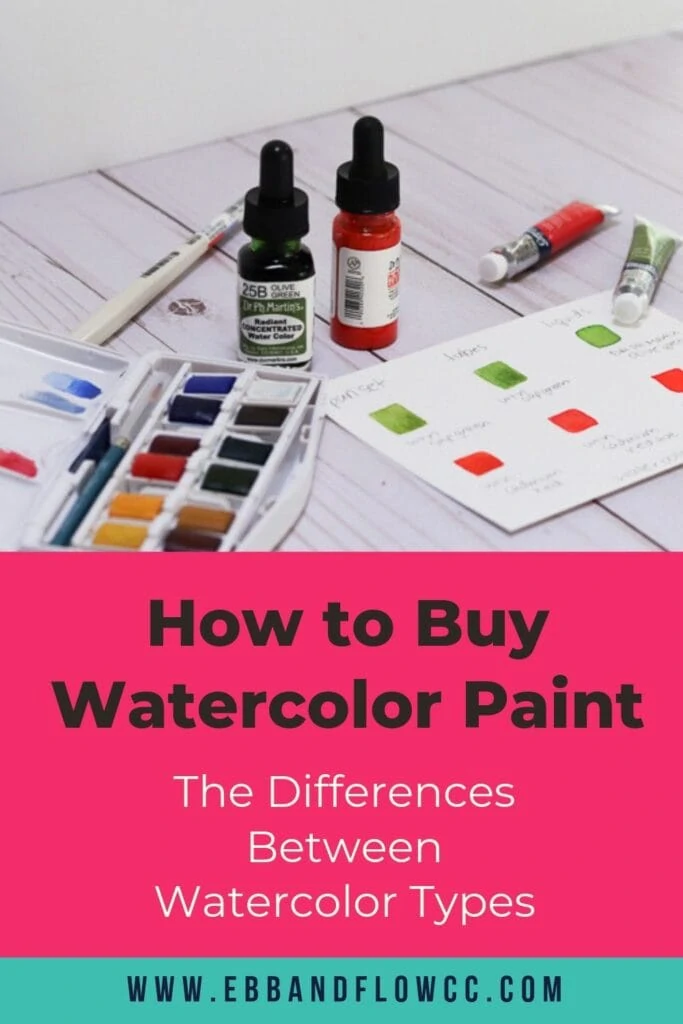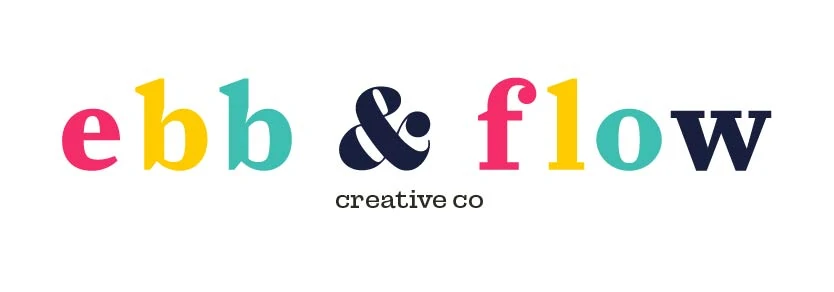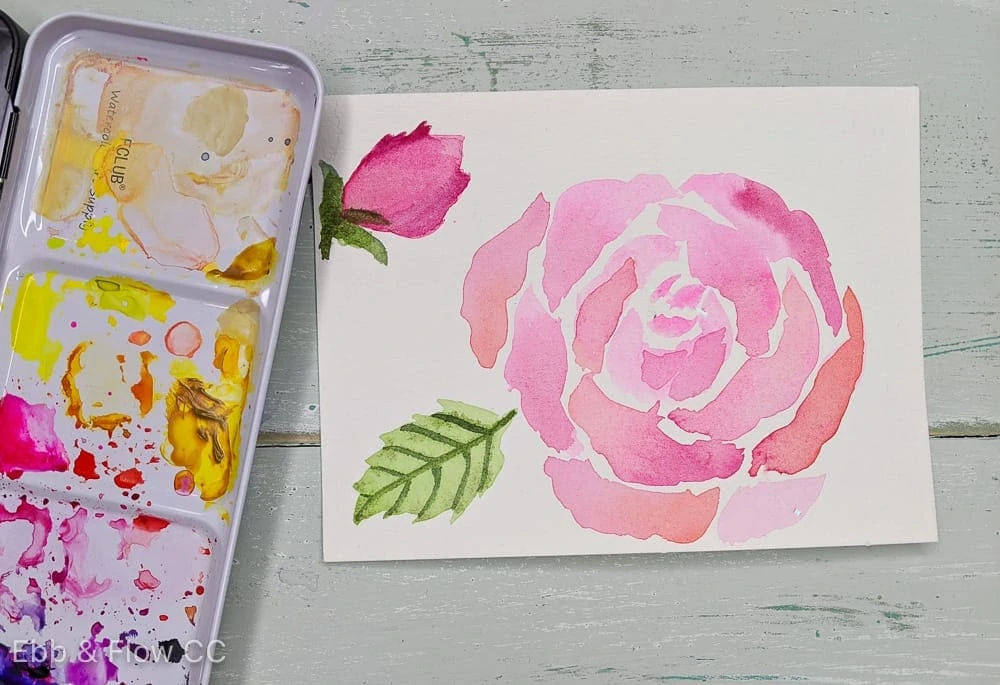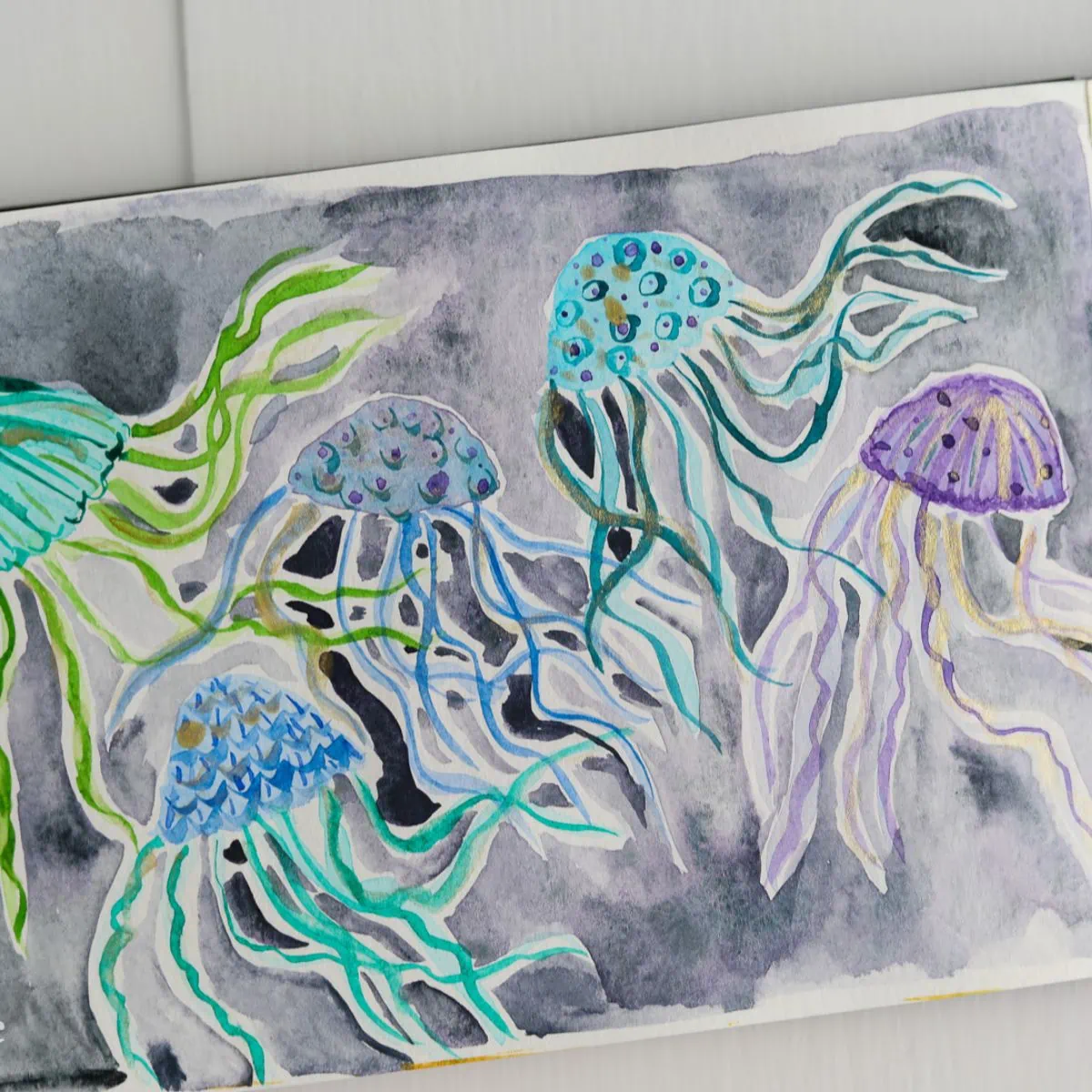The Ultimate Guide to Watercolor Types
What’s the difference between watercolor pans, tubes, and liquids? This guide to watercolor types will help make buying watercolors less confusing.
Learn even more about using watercolor paint!
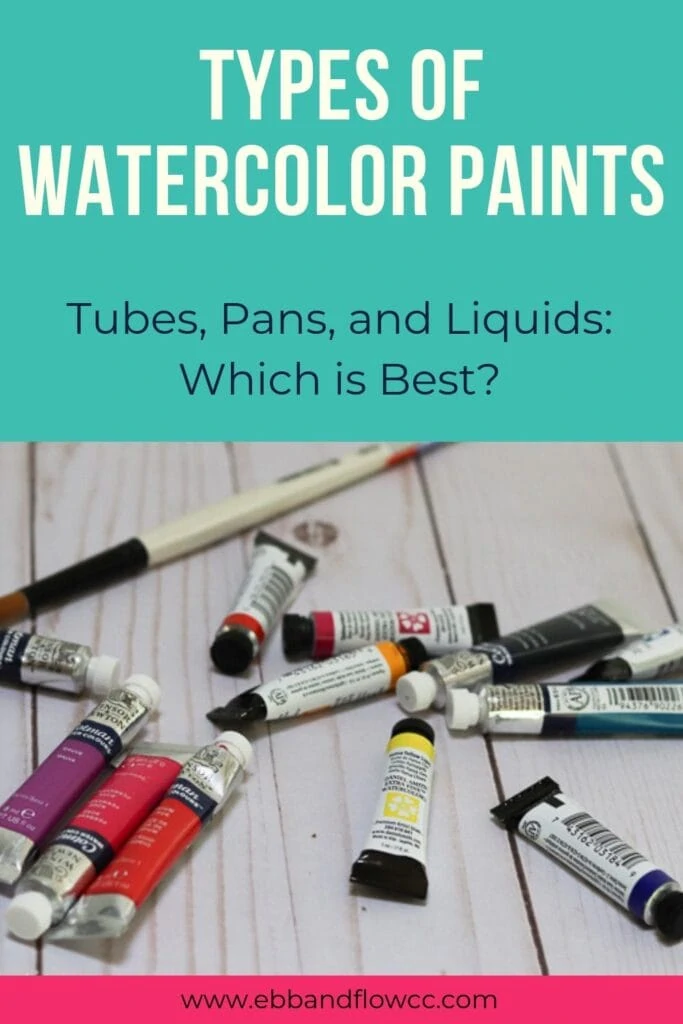
This post contains affiliate links. By purchasing an item through an affiliate link, I earn a small commission at no extra cost to you. As an Amazon Associate I earn from qualifying purchases.
I’ve included links to Blick where available because they often have better prices than Amazon. Plus, it’s so much fun to shop at Blick!
If you’re in a hurry, check out this quick look at my favorite watercolor sets.
The Ultimate Guide to Watercolor Types
Before I get into the nitty-gritty of watercolor types, I want to suggest that you buy the best watercolor paint you can afford when you start.
The learning curve is much easier with nicer paint. I’m not just saying that. I’ve been where you are and I’m a bargain hunter, so I tried to start with cheaper paints.
When the 18 color set is cheaper than the 6 color set, that feels like the better deal. But in the end, you’ll realize that you wasted money and should have bought the nicer set.
Trust me. I have 2! sets of cheap 18 color sets. That I hate. The paint cracks in the palettes, the colors are dull and boring and they don’t mix as beautifully as the more expensive sets.

Watercolors consist of pigments, binders and some other stuff. The more pigment, the nicer the colors are. Guess what the cheap brands skimp on? Yep, pigments.
Watercolor Types: Pans Vs Tubes Vs Liquid Watercolors
Some people say that tubes are more vibrant than pan sets, but I don’t see that with quality paint colors.

Please note that all watercolor types can and should be used together to get the best color variety and customization.
I have provided links to my favorite sets for convenience.
Watercolor Types: Pan Set
When I first started buying watercolors, I overlooked pan sets, thinking that tubes were better. However, watercolor pan sets can be incredibly pigmented. My pan set is now my favorite set!
Watercolor pan sets come in a travel case with the paint in either little square boxes or circles. You can also buy individual pans. Water is added to the colors to activate them. They can be used from the pans or mixed on a palette.
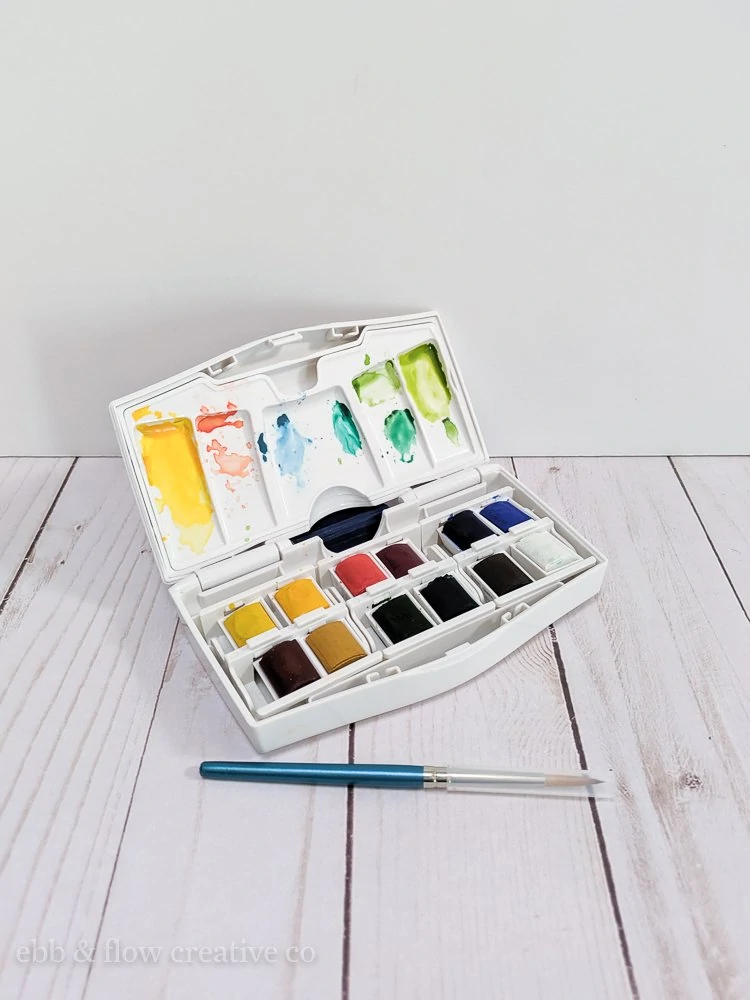
Pros of Pan Sets:
- Portable. This is a great feature if you travel a lot or paint outside.
- Ready to go. The colors are ready to be used by just adding water. There’s no squirting out each individual tube.
- Inexpensive. For the most part, pan sets are less expensive than tubes or liquids.
- Ready to go color palette. If you have trouble making decisions on colors, having a pre-determined color palette can help with indecision.
- You can make your own. There are empty pan sets that you can fill with your own favorite colors. (Blick link)
- They can be expanded. Most have space to add additional colors.
- Dry faster. (Not the painting, but the set itself.) This can be an important factor if you travel and paint.
Cons of Pan Sets:
- Easier to muddy the colors. Unless you’re very diligent about washing your brushes, it’s easier to get the pan set colors dirty.
- Harder to use with big brushes. However, this can be overcome by mixing the colors in a palette.
- Can be hard on brushes. It can be tempting to rub your brush into the pans to incorporate the water better, but this damages the brush hairs.
Watercolor Types: Tubes
Watercolor tubes look like tiny toothpaste tubes. You have to use a palette with them to dilute the color with water.
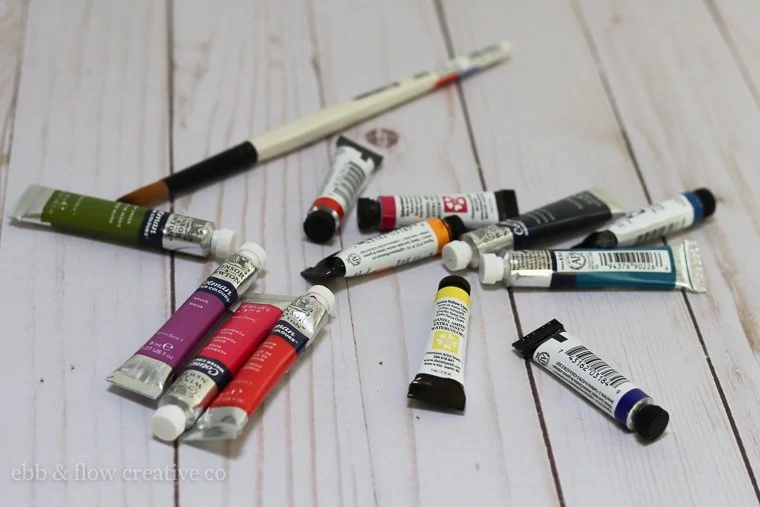
Pros of Tubes:
- Easier to find in individual colors. I’ve found that most art supply shops carry tubes, but I have yet to run across a local shop that carries individual pans.
- Easy to control how much I use. A tiny dab of paint goes a long way. But if it doesn’t get used, it can be used once it’s dry.
- Can be set in palettes and dried like a pan set. Tube paint can be used in palettes to be more convenient. Water reactivates them with no adverse reaction.
- A little easier to mix. Since you have to have a palette for mixing with water, I find tubes easier to mix since I have more space.
Cons of Tubes:
- Less convenient to use. It takes a few extra seconds to find the color, open it and squirt it out.
- More expensive. Tubes tend to be more expensive than pans.
- Can dry out.
- Lids can get stuck.
Interested in filling a palette with watercolor tube paint to make your own pan set? Read more!
Get easy tips for using watercolor tubes!
Watercolor Types: Liquid Watercolors
Liquid watercolors come in bottles with eyedroppers. They can be used at full strength or watered down in a palette. (Blick link)
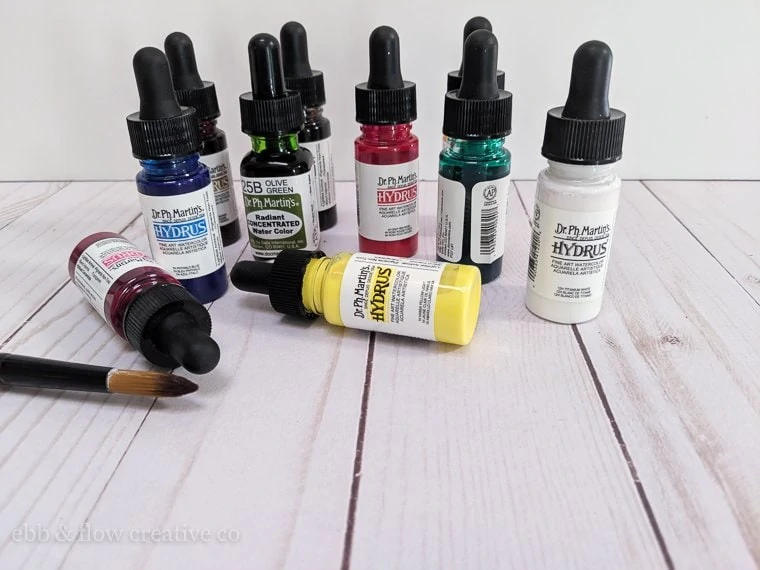
Pros of Liquid Watercolors:
- Brightness. These colors are so bright and add so much depth to a painting.
- Very concentrated. So a small bottle will last forever because you use a tiny dot.
Cons of Liquid Watercolors:
- Lightfastness. The Dr. Ph Martin colors are made with artificial pigments and will fade in the sun.
- Hard to use once they dry. They can be reused, but the result is typically a bit gritty.
- More expensive. A set of Dr. Ph Martin’s liquid watercolors is more expensive than pans or tubes.
- Stain the paper faster. This can make blending tricky unless you work fast.
- Stain plastic palettes easier. Not a deal-breaker, but important to know.
Learn more about using watercolor pencils!
Watercolor Types: Ink
Okay, so technically ink isn’t watercolor, but it can be used with watercolor for fabulous results, like these amazing textures that are created by dropping ink on a wet watercolor spot.

Ink comes in a bottle with an eye dropper. They are very pigmented and can be mixed with watercolors or layered over the top as accents.
I especially love white ink. It’s perfect for adding details to a painting, like stars in a sky.
Learn more about which pens to use with watercolors.
Student Grade VS Artist Grade
Student grade is the cheaper version of watercolor paint. It is less expensive because it contains less pigment and more binders.
Artist grade paint on the other hand contains more pigment and less binders. This results in paint that is brighter and nicer to work with. I can definitely tell the difference between the two grades when painting.
So which should you choose?
If you’re just dabbling in watercolor and want to make cards for family members, try the student grade paint from reputable brands like Winsor & Newton, Senneilier or Holbein.
If you plan on taking watercolors seriously, buy the artist grade. You will be much happier in the long run.
Other Considerations for Buying Watercolors
What are you planning on doing with your paintings? Do you plan on displaying them or scanning them to work on them digitally?
Watercolor paints have different qualities that make them better suited for certain things.
Lightfastness
Each watercolor paint has a lightfastness number. Lightfastness refers to whether they will fade in the sun or not. The ratings are I, II, III, and IV, with I being the best and IV being the worst.
You can find the rating on the tubes or on the manufacturer’s website. For example, here is the Windsor & Newton information about each color in the Cotman line of tubes.
Colors with low lightfastness need to be kept out of sunlight and stored in a dark box or behind glass.
Despite these qualities, I wouldn’t avoid using these colors. These colors are typically vibrant and fun. They’re perfect for scanning in to a computer and using digitally.

Fugitive Colors
Fugitive colors refer to colors that fade in the sun. They have the lowest lightfastness rating of IV. Opera Pink is notorious color known for this property.
Look for colors with “new” or “permanent” in the name to avoid this.
However, I wouldn’t necessarily avoid these colors. Just know that they’re better for work that will be scanned.
Reflective Qualities
If you plan on scanning your work, knowing about the reflective qualities of certain paint colors is also very important. Metallic and florescent paints in particular do not scan well.
For the most part, watercolors scan well, but the transparent parts can be difficult to deal with when there’s a lot of white space.
Gouache is a type of paint that you might want to consider if you scan a lot of your work. It’s very similar to watercolor but results in a more opaque finish. The matte quality of the paint is perfect for scanning.
Toxicity
Watercolors contain some pigments and elements that are possibly harmful. You can read more about toxicity in watercolors here.
If this is a concern, there are non-toxic versions of watercolors available. There are also cadmium-free versions available from Windsor & Newton.
I have not personally used them, so I don’t know what the quality is like.
What’s the Best Type of Watercolor Paint?
I don’t have a clear preference over which watercolor type is best. In fact, I love using all of them together to create my own color combinations.
My suggestion is to play with all of them and see what you like best.
You Might Also Like:
Pin for Later!

